
Thryptomene micrantha, commonly known as ribbed thryptomene, is a species of flowering plant in the family Myrtaceae and is endemic to south-eastern Australia. It is a spreading to erect shrub with egg-shaped leaves, the narrower end towards the base, and white flowers with five petals and five stamens.

Richea pandanifolia, the pandani or giant grass tree, is a distinctive endemic Tasmanian angiosperm. It is dicot of the family Ericaceae and is found in central, western and south west Tasmania. It is a favourite among hikers and nature lovers.

Archeria is a small genus of shrubs in the family Ericaceae. As currently circumscribed the group includes six species, all native to southern Australasia. Four of these are endemic to Tasmania, and the other two endemic to New Zealand.
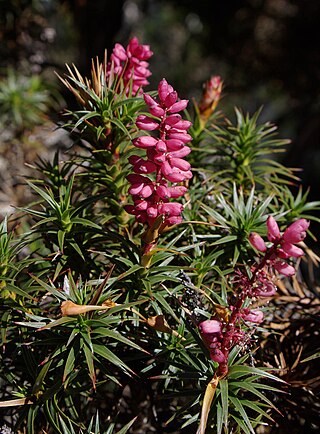
Richea scoparia, is a wide spread Tasmanian endemic plant. The genus Richea, forms part of the Ericaceae family, which are commonly heath-like shrubs. The name refers to the erect bushy growth habit, described as a broom-like shrub, most commonly referred to as the honey bush or simply scoparia to many bushwalkers.

Dracophyllum milliganii is a species of angiosperm in the family Ericaceae and the sub-family Epacridoideae. It is a distinctive alpine shrub, endemic to western Tasmania.

Leptospermum nitidum, commonly known as shiny tea-tree, is a species of compact shrub that is endemic to Tasmania. It has crowded, aromatic, elliptical leaves, white flowers about 15 mm (0.59 in) in diameter and fruit that remain on the plants until it is burned or dies.
Archeria comberi, also known as the pink mountain heath or comb heath, is a small, rare shrub endemic to Tasmania, Australia. As a member of the heath family, Ericaceae, this species is generally classified as a subalpine/ alpine species and shares many characteristics with other members of the family. It is an evergreen shrub 0.15m-1m in height, with pink flowers during the summer months, hence its common name pink mountain heath. Archeria comberi is often found growing among other species such as Nothofagus gunnii and Persoonia gunnii.

Archeria eriocarpa is a species of shrub in the family Ericaceae. It is endemic to Tasmania, Australia.

Archeria racemosa is a species of shrub in the family Ericaceae.

Archeria hirtella is a species of shrub in the family Ericaceae. It is native to Tasmania, Australia.

Orites revolutus , also known as narrow-leaf orites, is a Tasmanian endemic plant species in the family Proteaceae. Scottish botanist Robert Brown formally described the species in Transactions of the Linnean Society of London in 1810 from a specimen collected at Lake St Clair. Abundant in alpine and subalpine heath, it is a small to medium shrub 0.5 to 1.5 m tall, with relatively small, blunt leaves with strongly revolute margins. The white flowers grow on terminal spikes during summer. Being proteaceaous, O. revolutus is likely to provide a substantial food source for nectivorous animal species within its range.

Leptospermum rupestre, commonly known as alpine tea-tree or prostrate tea-tree, is a flowering shrub in the myrtle family, Myrtaceae. It is endemic to Tasmania. In alpine areas it assumes a prostrate habit while in subalpine areas it appears as a large shrub.
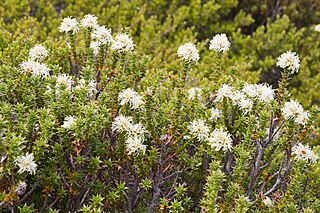
Richea sprengelioides is a species of flowering plant in the family Ericaceae. It is one of the 11 species within the genus Richea that are endemic to Australia, of which 9 are found only in Tasmania.
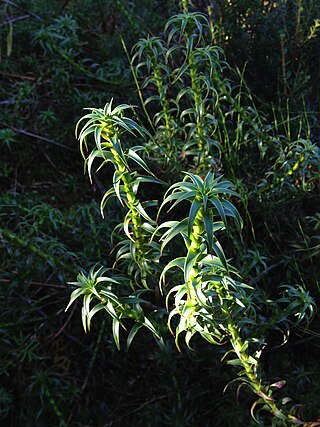
Richea gunnii, the bog candleheath or Gunns richea, is an endemic Tasmanian angiosperm. It is a dicot of the family Ericaceae and is found in Central, Western and North-east Tasmania.
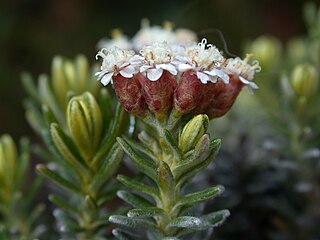
Ozothamnus ledifolius is a shrub, from the family Asteraceae and one of 54 species from the genus Ozothamnus. Harold Frederick Comber (1897–1969), an English horticulturist and plant collector, introduced Ozothamnus ledifolius in 1929 on mountains of Tasmania above 2500 ft. high from the seeds collected from 4000 ft. height.

Trochocarpa gunnii, commonly known as sweet-scented trochocarpa or fragrant purpleberry, is a common rainforest understorey shrub from the plant family Ericaceae endemic to Tasmania.
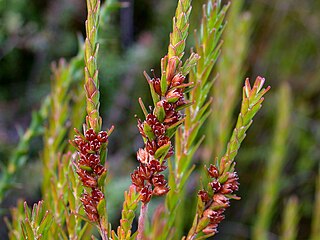
Epacris corymbiflora is a species of flowering plant in the heath family, Ericaceae, and is endemic to Tasmaina. It is a low, spreading shrub with elliptic leaves and white, tube-shaped flowers.

Epacris franklinii is a species of flowering plant in the heath family, Ericaceae, and is endemic to Tasmaina. It is an erect, spreading shrub with lance-shaped or elliptic leaves and white, tube-shaped flowers.
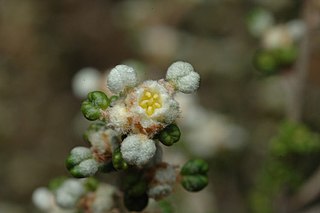
Spyridium lawrencei, commonly known as small-leaf spyridium or small-leaf dustymiller, is a species of flowering plant in the family Rhamnaceae and is endemic to Tasmania. It is an erect, compact or straggling shrub with small, leathery, round to heart-shaped leaves, and dense heads of hairy, cream-coloured flowers.

Cryptandra alpina, commonly known as alpine pearlflower, is a species of flowering plant in the family Rhamnaceae and is endemic to Tasmania. It is a small, prostrate shrub with slender branches, linear leaves, and tube-shaped white flowers arranged singly on the ends of branches.






















